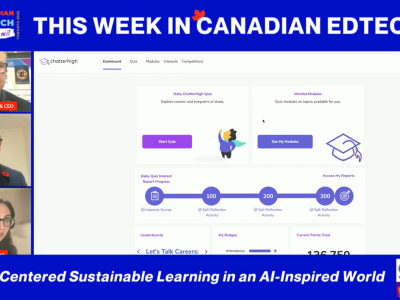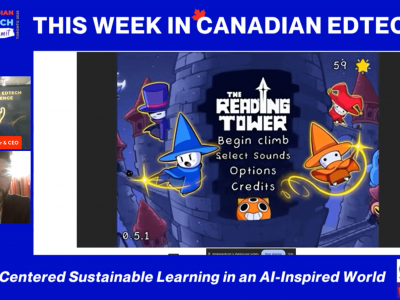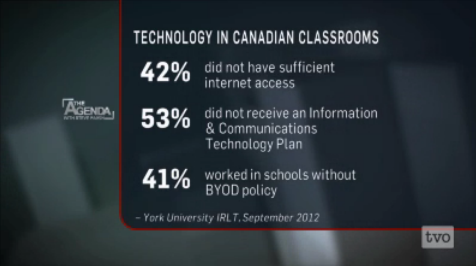By Timothy Gard, Educator, Toronto District School Board
@MindShareK12
By definition a nexus is a connection or series of connections linking two or more things. And that’s exactly what Google’s Nexus 7 is: a connection between all-things-Google including Gmail, Google+, YouTube, Google Docs, Calendar, Drive, Play, Books and Google’s NFC feature called Beam. To be honest, I expected as much when I first picked the Nexus up. Of course Google is going to link all of their services together, but could they do it seamlessly? Could they do it while keeping the cost down while creating a smaller screen experience that was powerful, easy to use and useful beyond playing games and creating and sending email? Is it a tablet that could be used in education in a meaningful way? Would it liberate the user from ‘hardware’ taking them into the cloud where they could create meaningful content anywhere, anytime? Yes and no.
The Google Nexus 7 is not an easy device to get if you’re shopping around in the local tech stores. It’s always sold out and salespeople are always promising that a new shipment was imminent. Well, why wait when you can order online? And that’s exactly what we did and it was delivered forthwith. No issues. The device itself is very compact, slim and comes with Jelly Bean, the latest version of Android, as you might expect. It has a quad-core processor, 1 MB of RAM and 8 GB internal storage. The HD resolution is 1280 x 800 but the pixel density is not particularly high which you will notice once you work with it. In the interest of saving battery life however, which the Nexus has abundantly, one can understand that Google wasn’t interested in having ASUS push out a high PPI for the device. The Nexus has a front facing camera that isn’t particularly impressive either. But again, price was certainly a factor – the higher the pixel quality of the camera the higher the price tag. The tablet does have a quad core processor though, and the ‘snappiness’ of the device certainly confirmed the higher-powered processor. In fact, I was quite impressed by how quickly Gmail and Chrome loaded and that was definitely a welcomed surprise given the size and weight of the tablet. Don’t let the size fool you!
The Google Nexus is a WiFi only device. That is a bit of a limiting factor when you think mobility is key in this day and age. With LTE/4G network connectivity growing exponentially most every tablet manufacturer is building at least one version of tablet that has this sort of connectivity. Again, price is the main reason why this tablet doesn’t have the high-speed mobile connections. From what I understand however the mobile connectivity option is forthcoming – stay tuned!
I’m also quite impressed by Jelly Bean, the latest Android OS from Google. It’ snappy, more refined and a bit more ‘glitzy’. It is however still ‘buggy’ and at times various functions didn’t seem to behave as smoothly as you would think given that Jelly Bean is the 4th generation incarnation of Android. For example, managing pages while reading – expanding the screen to get a closer look – was less than precise and it took me a bit of time to focus in at a particular level. Quite simply, it wasn’t smooth. I was also less than impressed by the keyboard. I’m a great test case for keyboard typing accuracy. If I can type 75% of my characters accurately then the tablet/phone has an awesome keyboard. I was scoring at about 50% or less. Not particularly scientific but after having typed on a myriad of phones and tablets it’s the best I have to go by with regards to keyboard accuracy and function and I would have to say that the Nexus tablet’s keyboard is not as good as it could be.
Let’s get to the crux of this review. Is this device education ready? To be honest, it is and it isn’t. If you’re an educator looking to use this device in your particular context I would wait for the second-generation version. It definitely has strong merits, especially with regards to the seamless connection to all-things-Google and with many districts using most of if not all of Google’s products you would be well served using this device however why invest now when the second generation will be more mature.
In fact, I didn’t have any issues using any of Google’s products on the Nexus. It certainly lived up to it’s name in that regard. But a tablet isn’t all about the apps and software. In an education context it’s about being able to use it in a multi-faceted way. By this I mean that the device has to be flexible as a hardware device as well as a software deliverer. Does it have a decent camera? Microphone? Does it have software applications that can take advantage of these built-in features so that students can create and synthesize? Is it so seamless that a student could pick it up and do all that they need to do to explore, collaborate, mix and re-mix, and connect with their world to develop higher-order thinking skills without being frustrated by the experience? The device is almost there.
The Google Nexus 7 is a great first tablet for Google in the smaller form factor field. The cost is not prohibitive, the battery life is amazing, there’s seamless integration with Google’s array of interdependent products and it’s fast. But it’s not ready for the education field just yet, or at least not in a way where you would invest heavily in this device and platform. It requires a bit more of a rugged build, a higher resolution camera with exceptional built-in recording features, a higher resolution screen and some other decent Android apps that can match anything that the other American mega-company can produce or has been produced by 3rd party developers. But Google’s on the right track. With a bit more tweaking and more attention to detail without destroying the price point, they could very well have a winner. And knowing Google, all we have to do is wait.










